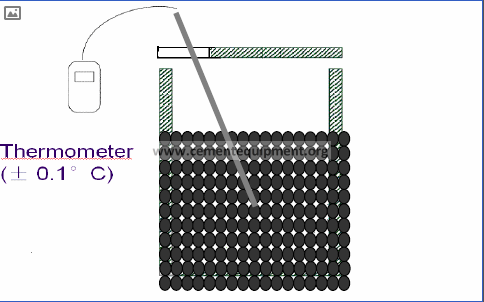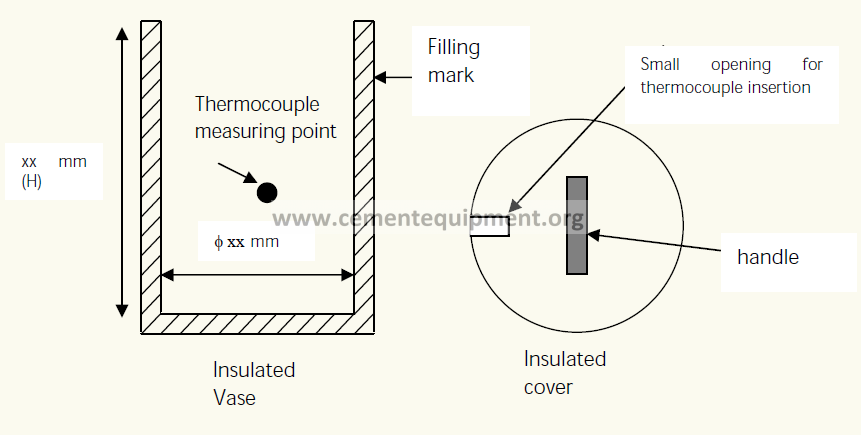Contents
How to measure clinker temperature at cooler exit
Introduction
Clinker temperature is measured for cooler efficiency and kiln heat balance analysis.
Measurement of clinker temperature technique must be conducted in a correct manner to obtain accurate results.
This procedure explains how to measure clinker temperature with minimum error at cooler exit.
To avoid large error in calculation, it is essential to use tools with high precision.
The measurement of the elevation of clinker temperature in an insulated vase.
The measurement of temperatures is made using a thermocouple placed at the center of vase.
The measurement is normally conducted by Process Technicians and Engineers.

Safety aspects
During sample collection, always wear hand glove to handle hot objects and wear goggle to protect from flying clinker dust.
Clinker sampling and analysis areas must be brightly lighted.
Only sampling points with safe access platforms are to be used.
Personal safety equipment is compulsory.
Prerequisites
Good knowledge on Plant Safety Procedures to ensure safe working environment
Determining the purposes of performing the clinker temperature measurement.
Cross checking the accuracy of clinker temperature
Calculation of sensible heat of clinker at cooler exit for cooler efficiency and heat balance calculation
To avoid large error in measurement:
It is essential to use tools with high precision. Always use certified and suitable tools such as thermocouple and electronic thermometers that can measure reading with accuracy of + 0.1 oC
Insert and place the thermocouple at the centre point of the insulated vase.
Time frame
The operation must be quick enough from taking clinker sample from the cooler discharge chute and store it into the insulated vase.
Tools
Certified K-Type thermocouple – select thermocouple which has been calibrated and certified fit for use.
When selecting Certified Electronic thermometer with + 0.1 oC accuracy – select electronic thermometer which has been calibrated and certified fit for use. Also use thermometer which can support the type of thermocouple you use.
Clinker scoop to collect clinker sample
Hand Gloves to handle hot objects
Safety Goggle to protect from flying clinker dust..
Helmet as basic safety working gear.
Protective clothing to protect from hot clinker dust and hot objects.
Walkie – talkies for communication with CCR operators.
Small notebook to record measurements.
Special made insulated vase with insulated cover.
Round insulated vase with handle and dimension of internal diameter of xx mm x length xx mm.
Round insulated cover with a small opening for thermocouple insertion.
Vase and cover to be insulated with 30 mm insulation wool.
Insulated vase to be marked with filling mark.

Action Steps
1. Clinker Sample collection
Determine a safe location, normally at the clinker discharge chute, where clinker sample can be collected.
2. Prepare for the clinker temperature measurement
Two personnel are required to perform the measurement.
Ensure that the clinker sampling and clinker temperature measurement area are brightly lighted.
Move the insulated vase close to the clinker sampling area.
Set up thermocouple and electronic thermometer. Ensure the probe connector is correctly connected to the terminal of the thermometer.
Prepare a record check sheet:
3. Measure the clinker temperature
Operator A is responsible for taking the reading of temperature.
Operator A places the thermocouple at the centre of the insulated vase.
Operator B takes clinker sample from clinker discharge chute and stores it into the insulated vase.
Operator B continues until it reaches the filling mark of the insulated vase.
Operator B then closes the top cover of the insulated vase.
Operator A waits for the temperature to stabilize and reach equilibrium.
Operator A notes the equilibrium temperature before it begins to decrease.
Record the temperature on a notebook.
Perform several sets of temperature readings to minimize the calculation errors.
The clinker temperature will be the average temperature of the few set of measurements.